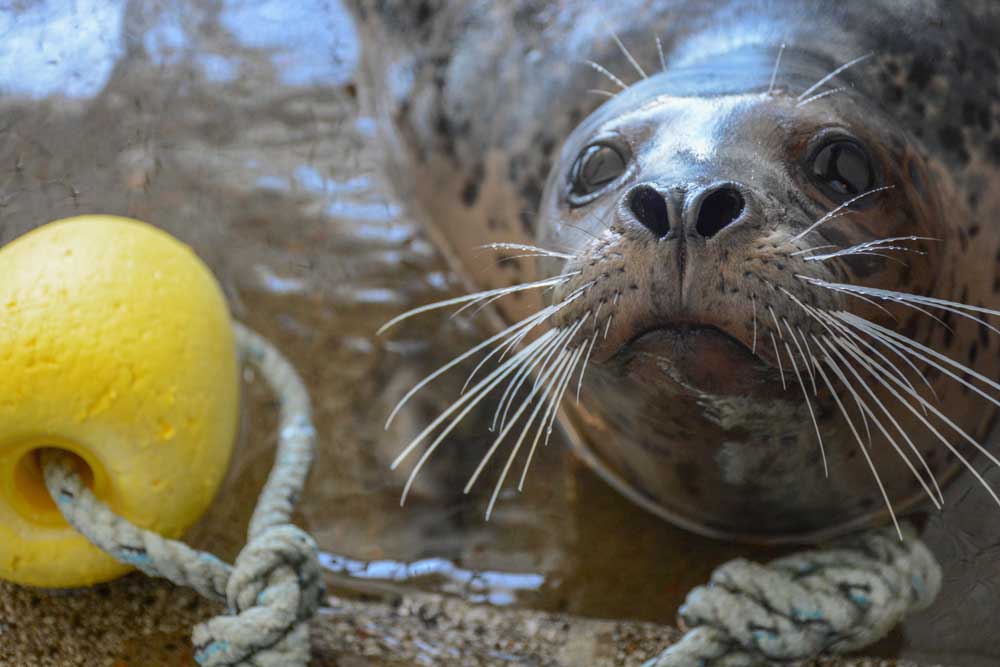Ambassadors of the sea
Published 6:27 am Tuesday, May 8, 2018

- Casey, born May 25, 2014, is the youngest seal born at the Seaside Aquarium.
Built in 1924, Arthur and Lillian Viggers opened Seaside Baths and Natatorium on Aug. 31 — three blocks north of the turnaround — to compete with the already-in-business Oates Natatorium on the Prom at Broadway.
The saltwater swimming pool was filled with filtered water drawn directly from the ocean and a children’s wading pool was at the entrance. One attraction was a large fountain in the shallow end of the main pool where multiple people could sit or stand, Seaside Aquarium general manager Keith Chandler.
Unfortunately, the natatorium didn’t survive the Great Depression and closed in 1931. It sat vacant for several years until a few investors, including George and Greta Smith, who managed the Depot Bay Aquarium, decided that Seaside was a good location for an aquarium.
Chandler, who has been with the aquarium since 1979, spoke at the April 26 History and Hops event presented by the Seaside Museum and Historical Society, held at Seaside Brewing Co. On the upper level of the building was an outdoor balcony viewing area to watch people swim.
By happenstance, the Smiths and investors came upon the vacant, yet promising-looking structure of the natatorium, Chandler said.
The building was already piped and plumbed, and with a few renovations, the Seaside Aquarium took shape.
A floor was built over the main pool, the children’s pool became the new seal tank, fish tanks were installed and the fountain was repurposed into a hexagonal fish tank in the center of the room. The aquarium opened May 25, 1937. The viewing balcony was soon removed to make room for the Sea Water Apartments, which opened in 1938 and remained popular rentals until 1970. The rooms are now used for storage and consumes any item Chandler can’t throw away.
Since its first renovation in 1937, the aquarium has gone through two more. In 1976, the building was resided. The apartment windows were removed and covered up due to constant leakage from the rain, and “to make the building structurally sound,” Chandler said. Another residing was done in 2001 and new windows were installed to give the building “the same look” as when it was first built.
When the aquarium acquired the 36-foot gray whale skeleton from Fort Stevens in 1998, an alcove was built onto the south side of the building, extending out over the original sidewalk.
In 2013, the aquarium added a display featuring the skeletons of a harbor seal and a harbor porpoise. That same year saw the remodel of the Discovery Center; expanding the touch tank area to allow for more space and above tank viewing, which Chandler believes people get more from when they visit. “It adds a different perspective when you look into a tank from above.”
The aquarium’s proximity to the ocean and its abundance of marine life has helped fill its tanks with a variety of fish, sea anemones, star fish and an octopus or two.
The aquarium has also been a place of refuge for injured or beached mammals and birds. In 1967, it took in a beluga whale, one of three in transit to Portland. Two died before arriving in Seaside and the third lived only a short while. In 1988, the aquarium received its first Orca whale from Sea World. The staff named it Feiko (pronounced Fake-o) because it was made of fiberglass. Feiko can be seen hanging above the ticket booth.
In addition to the touch and viewing tanks, the aquarium’s main attraction is its harbor seals.
Known worldwide for its successful breeding program, the aquarium was the first to breed harbor seals in captivity and currently has 11 in house — all born at the aquarium. Tubby, Jr. was the first successful birth born in 1952. Casey, the youngest, was born on the aquarium’s 77th anniversary May 25, 2014.
The famed harbor seals have always been a source of global news, whether in print or on television. In the days before Facebook and Twitter, there was Paul Harvey, a well-known radio broadcaster who reported on the newsworthy activities at the aquarium.
One such bit of news that caught Harvey’s attention was the abduction of Victor the lobster. Donated by Safeway, the lobster was stolen in 1994. When the thief saw Chandler chasing him, he dropped the lobster and took off. With a broken shell, the lobster died a few days later.
Since the tragic incident involving Victor, the aquarium created an interpretive center. Staffed full time during operating hours, someone is always available to educate, provide lessons and answer questions about the aquarium, its inhabitants, and the beach.
Ambassadors
Chandler and his staff continue the aquarium’s ambassadorship for education through public awareness programs and partnerships such as:
• Seaside Beach Discover Program
• Marine Mammal Stranding Network
• A drop-off hub for the Wildlife Center of the North Coast
• Friends with Friends of Haystack Rock
• Discovery cards Program
“We started the Discovery Cards to explain the different events people had questions about on the beach,” Chandler explained. The first card created was about diatoms and now includes 25 cards.
The aquarium remains the oldest, privately-owned aquarium on the west coast, and on May 25, it will be 81 years old.





